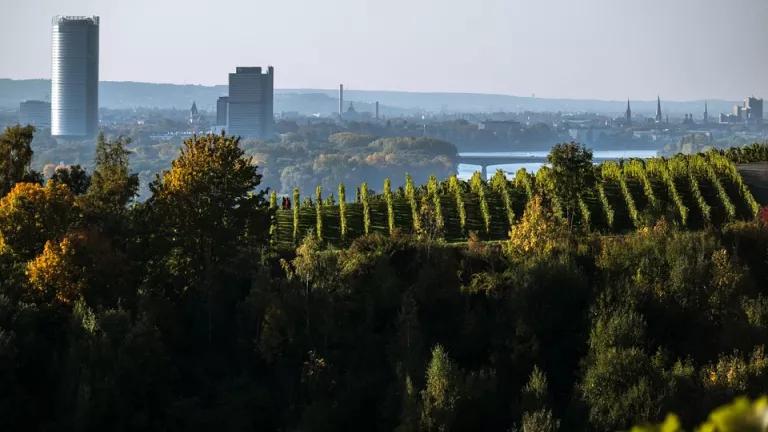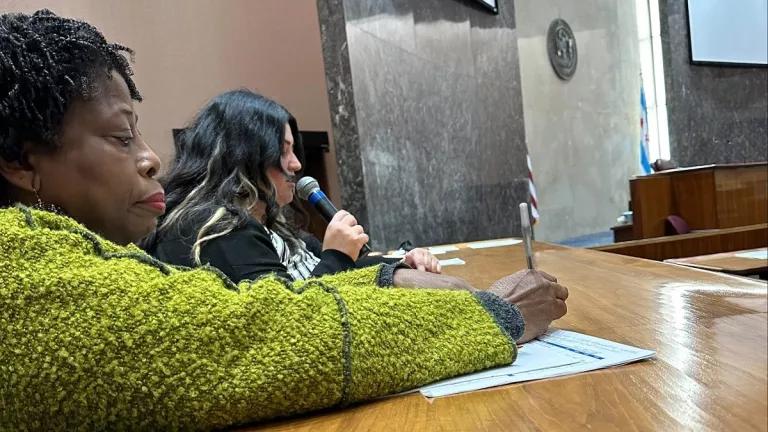Cities Stand United on Paris Agreement at COP-23

Facing a new reality in the wake of monster storms, unprecedented flooding, dangerous and record-breaking heat and drought, wildfires and other challenges, cities stand determined to set their own framework for climate action.
That framework increasingly includes not just working to mitigate the immediate problem but reaching across geographical and political boundaries to increase resilience, overcome racial divisions and inequality embedded in city planning of the past, and improve health and quality of life for urban residents.
Mayors are listening to nature and their citizenry, and they know that inaction means huge costs in repairs, rebuilding and healthcare, and loss of economic opportunity. They understand the definition of sustainability as they face increased competition and an influx of people looking for access to living wages, quality schools, affordable housing and safe and diverse neighborhoods.
The way these forward-thinking cities see it, they have the wherewithal, political will and flexibility to face the real work that needs to be done, and thousands of them are banding together to flex the international clout they captured during the historic Paris climate agreement.
More than 350 U.S. “Climate Mayors” have pledged to commit to the goals laid out in Paris to reduce emissions by 80% by 2050, and many more intend to go farther. Since Paris, more than 7,000 cities, representing 678 million people globally, have pledged to cut greenhouse-gas emissions, working through the Global Covenant of Mayors for Climate and Energy. In the United States, more than 25 cities in 17 states, with populations totaling more than 5 million have adopted resolutions that will enable them to get 100 percent of their electricity from renewable sources like wind and solar.
Going into COP-23, the second major follow-up meeting to COP-21 in Paris, cities are more poised than ever to help lead the world toward those goals. U.S. cities, in particular, are heralding their accomplishments and pushing forward despite the Trump administration’s pullout from the Paris agreement.
Dozens of U.S. governors, mayors and business leaders will be in attendance at COP-23, demonstrating to the world their unified commitment to uphold the Paris agreement in this new era of distributed climate leadership.
Following are highlights of developments for organized city action since Paris:
- Mayors of global cities came together for the first time since President Trump announced the United States would withdraw from the Paris agreement, gathering at Climate Week NYC and setting the stage for the first Together4Climate event in Paris Oct. 22. In Paris, mayors and business leaders focused on three policy areas—mobility, energy and urban planning.
- Representing a total of 80 million people, 12 international mayors, including Los Angeles’ Eric Garcetti and Seattle’s Tim Burgess, signed the Fossil-Fuel-Free Streets Declaration as part of the Paris meeting, pledging to procure only electric and other zero-emission buses beginning in 2025 and ensuring that major parts of their cities are zero emission by 2030. The cities would effectively ban internal combustion engines in certain urban areas and incentivize commuters to adopt alternative forms of transportation such as walking, cycling and the use of public or shared transportation. The cities will publicly report their progress every two years.
- Also in Paris, Paris Mayor Anne Hidalgo and L.A. Mayor Garcetti, following the joint awarding of the Olympic Games in their cities in 2024 and 2028 respectively, signed a Memorandum of Understanding (MoU) on Olympic cooperation, pledging to have the greenest Olympics in modern history.
- In June, the U.S. Conference of Mayors adopted a set of ambitious goals, including a commitment to meet 100 percent of urban electricity needs with renewable energy by 2035.
- Since June 5, more than 2,500 leaders from U.S. cities, state houses, colleges and businesses, representing more than 130 million Americans and $6.2 trillion of the U.S. economy signed the We Are Still In declaration in support of upholding the Paris agreement goals.
- In November 2016, mayors of 71 small and large American cities, comprising over 38 million Americans, joined in the U.S. Mayors’ National Climate Action Agenda (MNCAA) and wrote a letter to President Trump stating their support of the Paris accords.
- In December 2016, mayors of the 90 global megacities in the C40 network met at the Global Mayor’s Climate Summit in Mexico City, doubling down on climate actions in cities, noting they represented 25% of global GDP and one in 12 people worldwide.
- C40 Cities in December 2016 released a report, Deadline 2020, detailing how the infrastructure decisions cities make in the next four years will either put them on a climate-safe path or spell global disaster.
- Mayors will have an even more formal role within the U.N. through the Intergovernmental Panel on Climate Change, the scientific body that advises national governments on the issue. In 2018, scientists will convene for the first CitiesIPCC conference to prepare a research agenda for the panel.
- In December, Chicago will host a “Global Covenant of Mayors for Climate and Energy North American Climate Summit” to bring together leaders of cities in the U.S., Canada and Mexico. Participants will include Hidalgo, Montreal’s Denis Coderre, Austin Mayor Steve Adler, Atlanta’s Kasim Reed and a host of other mayors from around the world.
- Boston announced it will host the first international climate summit for cities in the summer of 2018 to discuss how to combat global warming on the local level.
As the new C40 Cities100 report found, more cities than ever before are using climate action as a tool to transform their metropolises into better places to live.
We see it specifically in our own work, with 20 cities in the groundbreaking City Energy Project, which we co-lead with the Institute for Market Transformation, creating a national movement toward energy efficiency in large buildings in cities. Such buildings can burn as much as 75 percent of a city’s energy, much of it wasted. And, we see it in the six localities in the Strong, Prosperous, And Resilient Cities Challenge (SPARCC)—an innovative program in which cities are rethinking infrastructure projects to make them more equitable and resilient.
We see it in New York City and New Orleans as we note the anniversaries of their respective devastating storms, with New Orleans issuing a climate action plan for the first time to cut fossil-fuel emissions by half by 2030, and we hope to see more change in Houston and Florida cities as well. Atlanta, too, has become a beacon for action in the South, approving a resolution in May to power the city entirely on renewable energy sources, including wind and solar, by 2035.
It’s difficult to list all the progress U.S. cities are making, because they are doing more and more, but a high point is that 18 of the top 20 most populous cities—with an estimated population of more than 30 million Americans—have set a quantified emissions reduction target, including the top five:
- New York, with plans to reduce greenhouse gas emissions 40% by 2030 from 2005 levels and reduce emissions from private sector buildings 30% by 2025 from 2005 levels.
- Los Angeles, with plans to reduce emissions 45% by 2025 from 1990 levels, and 20% by 2020; derive 55% of electricity from renewable sources by 2030; and has passed an ordinance for buildings over a certain square foot threshold to benchmark and make public their annual energy and water consumption.
- Chicago, with plans to reduce emissions 25% by 2020 from 1990 levels; the Retrofit Chicago initiative seeks to reduce energy use by 20% across 76 buildings.
- Houston, with plans to reduce emissions from government operations 42% by 2016 from 2007 levels; supply 50% of municipal electricity from renewable sources by 2015; municipal energy retrofit program to upgrade 6 million square feet of city buildings to achieve 30% energy reductions.
- Phoenix, with plans to reduce emissions from municipal operations 40% by 2025 from 2005 levels, with a citywide 2025 target under development for late 2017; supply 15% of energy demand with renewable sources by 2025; implemented advanced methane capture systems at city-owned landfills.
Cities consume more than two-thirds of the world’s energy, accounting for over 70 percent of carbon emissions globally. By 2030, two-thirds of the world’s population will be living in cities and the geographical area covered by cities could triple.
The way many of the world’s city leaders see it, those metrics present an opportunity—a historic chance for those with a stake in urban development and revitalization to help spur cities to do what they do best: innovate and take action for the sake of improving the places in which people live.
Indeed, cities will have a huge role to play in implementation of the Paris goals. According to the international C40 climate leadership group, cities alone can take 40 percent of the action necessary to reach the Paris targets, regardless of what national governments do.
In the U.S., that could mean fulfilling the Paris pledge as part of a global coalition regardless of Washington’s official pullout. The alternative, many city leaders know, is potential climate catastrophe.
“Air pollution caused by petrol and diesel vehicles is killing millions of people in cities around the world,” Hidalgo said in late October. “The same emissions are also causing climate change.”
So simple yet so devastating a statement—one that cities on the front lines seem to hear more clearly than perhaps anyone else.




